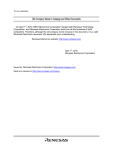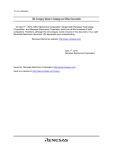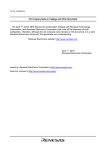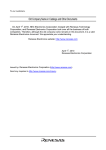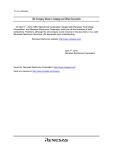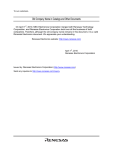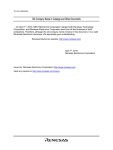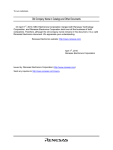Download SH7729/SH7709A Evaluation Chip Board (HS7729EBH81H
Transcript
To our customers, Old Company Name in Catalogs and Other Documents On April 1st, 2010, NEC Electronics Corporation merged with Renesas Technology Corporation, and Renesas Electronics Corporation took over all the business of both companies. Therefore, although the old company name remains in this document, it is a valid Renesas Electronics document. We appreciate your understanding. Renesas Electronics website: http://www.renesas.com April 1st, 2010 Renesas Electronics Corporation Issued by: Renesas Electronics Corporation (http://www.renesas.com) Send any inquiries to http://www.renesas.com/inquiry. Notice 1. 2. 3. 4. 5. 6. 7. All information included in this document is current as of the date this document is issued. Such information, however, is subject to change without any prior notice. Before purchasing or using any Renesas Electronics products listed herein, please confirm the latest product information with a Renesas Electronics sales office. Also, please pay regular and careful attention to additional and different information to be disclosed by Renesas Electronics such as that disclosed through our website. Renesas Electronics does not assume any liability for infringement of patents, copyrights, or other intellectual property rights of third parties by or arising from the use of Renesas Electronics products or technical information described in this document. No license, express, implied or otherwise, is granted hereby under any patents, copyrights or other intellectual property rights of Renesas Electronics or others. You should not alter, modify, copy, or otherwise misappropriate any Renesas Electronics product, whether in whole or in part. Descriptions of circuits, software and other related information in this document are provided only to illustrate the operation of semiconductor products and application examples. You are fully responsible for the incorporation of these circuits, software, and information in the design of your equipment. Renesas Electronics assumes no responsibility for any losses incurred by you or third parties arising from the use of these circuits, software, or information. When exporting the products or technology described in this document, you should comply with the applicable export control laws and regulations and follow the procedures required by such laws and regulations. You should not use Renesas Electronics products or the technology described in this document for any purpose relating to military applications or use by the military, including but not limited to the development of weapons of mass destruction. Renesas Electronics products and technology may not be used for or incorporated into any products or systems whose manufacture, use, or sale is prohibited under any applicable domestic or foreign laws or regulations. Renesas Electronics has used reasonable care in preparing the information included in this document, but Renesas Electronics does not warrant that such information is error free. Renesas Electronics assumes no liability whatsoever for any damages incurred by you resulting from errors in or omissions from the information included herein. Renesas Electronics products are classified according to the following three quality grades: “Standard”, “High Quality”, and “Specific”. The recommended applications for each Renesas Electronics product depends on the product’s quality grade, as indicated below. You must check the quality grade of each Renesas Electronics product before using it in a particular application. You may not use any Renesas Electronics product for any application categorized as “Specific” without the prior written consent of Renesas Electronics. Further, you may not use any Renesas Electronics product for any application for which it is not intended without the prior written consent of Renesas Electronics. Renesas Electronics shall not be in any way liable for any damages or losses incurred by you or third parties arising from the use of any Renesas Electronics product for an application categorized as “Specific” or for which the product is not intended where you have failed to obtain the prior written consent of Renesas Electronics. The quality grade of each Renesas Electronics product is “Standard” unless otherwise expressly specified in a Renesas Electronics data sheets or data books, etc. “Standard”: 8. 9. 10. 11. 12. Computers; office equipment; communications equipment; test and measurement equipment; audio and visual equipment; home electronic appliances; machine tools; personal electronic equipment; and industrial robots. “High Quality”: Transportation equipment (automobiles, trains, ships, etc.); traffic control systems; anti-disaster systems; anticrime systems; safety equipment; and medical equipment not specifically designed for life support. “Specific”: Aircraft; aerospace equipment; submersible repeaters; nuclear reactor control systems; medical equipment or systems for life support (e.g. artificial life support devices or systems), surgical implantations, or healthcare intervention (e.g. excision, etc.), and any other applications or purposes that pose a direct threat to human life. You should use the Renesas Electronics products described in this document within the range specified by Renesas Electronics, especially with respect to the maximum rating, operating supply voltage range, movement power voltage range, heat radiation characteristics, installation and other product characteristics. Renesas Electronics shall have no liability for malfunctions or damages arising out of the use of Renesas Electronics products beyond such specified ranges. Although Renesas Electronics endeavors to improve the quality and reliability of its products, semiconductor products have specific characteristics such as the occurrence of failure at a certain rate and malfunctions under certain use conditions. Further, Renesas Electronics products are not subject to radiation resistance design. Please be sure to implement safety measures to guard them against the possibility of physical injury, and injury or damage caused by fire in the event of the failure of a Renesas Electronics product, such as safety design for hardware and software including but not limited to redundancy, fire control and malfunction prevention, appropriate treatment for aging degradation or any other appropriate measures. Because the evaluation of microcomputer software alone is very difficult, please evaluate the safety of the final products or system manufactured by you. Please contact a Renesas Electronics sales office for details as to environmental matters such as the environmental compatibility of each Renesas Electronics product. Please use Renesas Electronics products in compliance with all applicable laws and regulations that regulate the inclusion or use of controlled substances, including without limitation, the EU RoHS Directive. Renesas Electronics assumes no liability for damages or losses occurring as a result of your noncompliance with applicable laws and regulations. This document may not be reproduced or duplicated, in any form, in whole or in part, without prior written consent of Renesas Electronics. Please contact a Renesas Electronics sales office if you have any questions regarding the information contained in this document or Renesas Electronics products, or if you have any other inquiries. (Note 1) “Renesas Electronics” as used in this document means Renesas Electronics Corporation and also includes its majorityowned subsidiaries. (Note 2) “Renesas Electronics product(s)” means any product developed or manufactured by or for Renesas Electronics. To all our customers Regarding the change of names mentioned in the document, such as Hitachi Electric and Hitachi XX, to Renesas Technology Corp. The semiconductor operations of Mitsubishi Electric and Hitachi were transferred to Renesas Technology Corporation on April 1st 2003. These operations include microcomputer, logic, analog and discrete devices, and memory chips other than DRAMs (flash memory, SRAMs etc.) Accordingly, although Hitachi, Hitachi, Ltd., Hitachi Semiconductors, and other Hitachi brand names are mentioned in the document, these names have in fact all been changed to Renesas Technology Corp. Thank you for your understanding. Except for our corporate trademark, logo and corporate statement, no changes whatsoever have been made to the contents of the document, and these changes do not constitute any alteration to the contents of the document itself. Renesas Technology Home Page: http://www.renesas.com Renesas Technology Corp. Customer Support Dept. April 1, 2003 User’s Manual SH7729/SH7709A Evaluation Chip Board (HS7729EBH81H/ HS7709AEBH81H) for the E8000 Emulator User’s Manual www.renesas-electoronics.com Cautions 1. Hitachi neither warrants nor grants licenses of any rights of Hitachi’s or any third party’s patent, copyright, trademark, or other intellectual property rights for information contained in this document. Hitachi bears no responsibility for problems that may arise with third party’s rights, including intellectual property rights, in connection with use of the information contained in this document. 2. Products and product specifications may be subject to change without notice. Confirm that you have received the latest product standards or specifications before final design, purchase or use. 3. Hitachi makes every attempt to ensure that its products are of high quality and reliability. However, contact Hitachi’s sales office before using the product in an application that demands especially high quality and reliability or where its failure or malfunction may directly threaten human life or cause risk of bodily injury, such as aerospace, aeronautics, nuclear power, combustion control, transportation, traffic, safety equipment or medical equipment for life support. 4. Design your application so that the product is used within the ranges guaranteed by Hitachi particularly for maximum rating, operating supply voltage range, heat radiation characteristics, installation conditions and other characteristics. Hitachi bears no responsibility for failure or damage when used beyond the guaranteed ranges. Even within the guaranteed ranges, consider normally foreseeable failure rates or failure modes in semiconductor devices and employ systemic measures such as fail-safes, so that the equipment incorporating Hitachi product does not cause bodily injury, fire or other consequential damage due to operation of the Hitachi product. 5. This product is not designed to be radiation resistant. 6. No one is permitted to reproduce or duplicate, in any form, the whole or part of this document without written approval from Hitachi. 7. Contact Hitachi’s sales office for any questions regarding this document or Hitachi semiconductor products. Preface This manual describes how to connect and operate the EV-chip board. The EV-chip board incorporates an evaluation chip for connection to a user system that uses the SH7729, SH7709A with the E8000 emulator. Read and understand Sec. 3, “Preparation before Use” of the E8000 Emulator User’s Manual before using this EV-chip board. CAUTION The EV-chip board is only for connection to a user system that uses the SH7729, SH7709A with the E8000 emulator. It cannot be used for user systems that target other devices. The EV-chip board is connected only with the device control board HS7729EDD81H. Read section 2, Configuration, in Part I, E8000 Guide, of the E8000 SH7729/SH7709A Emulator User's Manual. IMPORTANT INFORMATION READ FIRST • READ this user's manual before using this evaluation chip board (hereafter referred to as the EV-chip board) for Hitachi microcomputer HD6417729 or HD6417709A. • KEEP the user's manual handy for future reference. Do not attempt to use the EV-chip board until you fully understand its mechanism. EV-Chip Board: Throughout this document, the term "EV-chip board" shall be defined as the following products produced only by Hitachi, Ltd. excluding all subsidiary products. • EV-chip board • Device control board The user system or a host computer is not included in this definition. Purpose of the EV-Chip Board: This EV-chip board is a software and hardware development tool for systems employing the Hitachi microcomputer HD6417729 or HD6417709A (hereafter referred to as SH7729/SH7709A). The E8000 emulator and the user system can be connected through the EV-chip board. This EVchip board must only be used for the above purpose. Improvement Policy: Hitachi, Ltd. (including its subsidiaries, hereafter collectively referred to as Hitachi) pursues a policy of continuing improvement in design, performance, and safety of the EV-chip board. Hitachi reserves the right to change, wholly or partially, the specifications, design, user's manual, and other documentation at any time without notice. Target User of the EV-Chip Board: This EV-chip board should only be used by those who have carefully read and thoroughly understood the information and restrictions contained in the user's manual. Do not attempt to use the EV-chip board until you fully understand its mechanism. It is highly recommended that first-time users be instructed by users that are well versed in the operation of the EV-chip board. I LIMITED WARRANTY Hitachi warrants its EV-chip boards to be manufactured in accordance with published specifications and free from defects in material and/or workmanship. Hitachi, at its option, will repair or replace any EV-chip boards returned intact to the factory, transportation charges prepaid, which Hitachi, upon inspection, determine to be defective in material and/or workmanship. The foregoing shall constitute the sole remedy for any breach of Hitachi's warranty. See the Hitachi warranty booklet for details on the warranty period. This warranty extends only to you, the original Purchaser. It is not transferable to anyone who subsequently purchases the EV-chip board from you. Hitachi is not liable for any claim made by a third party or made by you for a third party. DISCLAIMER HITACHI MAKES NO WARRANTIES, EITHER EXPRESS OR IMPLIED, ORAL OR WRITTEN, EXCEPT AS PROVIDED HEREIN, INCLUDING WITHOUT LIMITATION THEREOF, WARRANTIES AS TO MARKETABILITY, MERCHANTABILITY, FITNESS FOR ANY PARTICULAR PURPOSE OR USE, OR AGAINST INFRINGEMENT OF ANY PATENT. IN NO EVENT SHALL HITACHI BE LIABLE FOR ANY DIRECT, INCIDENTAL OR CONSEQUENTIAL DAMAGES OF ANY NATURE, OR LOSSES OR EXPENSES RESULTING FROM ANY DEFECTIVE EV-CHIP BOARD, THE USE OF ANY EV-CHIP BOARD, OR ITS DOCUMENTATION, EVEN IF ADVISED OF THE POSSIBILITY OF SUCH DAMAGES. EXCEPT AS EXPRESSLY STATED OTHERWISE IN THIS WARRANTY, THIS EV-CHIP BOARD IS SOLD "AS IS ", AND YOU MUST ASSUME ALL RISK FOR THE USE AND RESULTS OBTAINED FROM THE EV-CHIP BOARD. II State Law: Some states do not allow the exclusion or limitation of implied warranties or liability for incidental or consequential damages, so the above limitation or exclusion may not apply to you. This warranty gives you specific legal rights, and you may have other rights which may vary from state to state. The Warranty is Void in the Following Cases: Hitachi shall have no liability or legal responsibility for any problems caused by misuse, abuse, misapplication, neglect, improper handling, installation, repair or modifications of the EV-chip board without Hitachi's prior written consent or any problems caused by the user system. All Rights Reserved: This user's manual and EV-chip board are copyrighted and all rights are reserved by Hitachi. No part of this user's manual, all or part, may be reproduced or duplicated in any form, in hard-copy or machine-readable form, by any means available without Hitachi's prior written consent. Other Important Things to Keep in Mind: 1. Circuitry and other examples described herein are meant merely to indicate the characteristics and performance of Hitachi's semiconductor products. Hitachi assumes no responsibility for any intellectual property claims or other problems that may result from applications based on the examples described herein. 2. No license is granted by implication or otherwise under any patents or other rights of any third party or Hitachi. Figures: Some figures in this user's manual may show items different from your actual system. Limited Anticipation of Danger: Hitachi cannot anticipate every possible circumstance that might involve a potential hazard. The warnings in this user's manual and on the EV-chip board are therefore not all inclusive. Therefore, you must use the EV-chip board safely at your own risk. III SAFETY PAGE READ FIRST • READ this user's manual before using this EV-chip board. • KEEP the user's manual handy for future reference. Do not attempt to use the EV-chip board until you fully understand its mechanism. DEFINITION OF SIGNAL WORDS This is the safety alert symbol. It is used to alert you to potential personal injury hazards. Obey all safety messages that follow this symbol to avoid possible injury or death. DANGER WARNING CAUTION CAUTION DANGER indicates an imminently hazardous situation which, if not avoided, will result in death or serious injury. WARNING indicates a potentially hazardous situation which, if not avoided, could result in death or serious injury. CAUTION indicates a potentially hazardous situation which, if not avoided, may result in minor or moderate injury. CAUTION used without the safety alert symbol indicates a potentially hazardous situation which, if not avoided, may result in property damage. NOTE emphasizes essential information. IV WARNING Observe the precautions listed below. Failure to do so will result in a FIRE HAZARD and will damage the user system and the EV-chip board or will result in PERSONAL INJURY. The USER PROGRAM will be LOST. 1. Always switch OFF the EV-chip board and user system before connecting or disconnecting any CABLES or PARTS. 2. Always before connecting, make sure that pin 1 on both sides is correctly aligned. V Warnings on EV-Chip Board Usage Warnings described below apply as long as you use the EV-chip board. Be sure to read and understand the warnings below before using the EV-chip board. Note that these are the main warnings, not the complete list. WARNING Always switch OFF the EV-chip board and user system before connecting or disconnecting any CABLES or PARTS. Failure to do so will result in a FIRE HAZARD and will damage the user system and the EV-chip board or will result in PERSONAL INJURY. The USER PROGRAM will be LOST. VI CAUTION Place the emulator station and EV-chip board so that the cable is not bent or twisted. A bent or twisted cable will impose stress on the user interface leading to connection or contact failure. Make sure that the emulator station is placed in a secure position so that it does not move during use nor impose stress on the user interface. HITACHI E8000 POWER RUN HITA CHI E80 00 HITACHI E8000 POWER RUN POWER RUN VII Contents Section 1 1.1 1.2 Components .....................................................................................1 EV-Chip Board Components ............................................................................................ 1 Component Names............................................................................................................ 3 Section 2 Preparation before Use........................................................................5 2.1 2.2 Preparing the User System ................................................................................................ 5 Connector Mounting Position of the User System ............................................................ 9 Section 3 Connecting the EV-Chip Board to the User System...........................13 3.1 3.2 3.3 Connecting the HS7729PWB30H/HS7709APWB30H to the User System ..................... 13 3.1.1 Installing the QFP-208 Package IC Socket .......................................................... 13 3.1.2 Connecting the HS7729PWB30H/HS7709APWB30H to the User System ........ 15 Connecting the Trace Cables ............................................................................................ 20 3.2.1 Connecting the Trace Cables to the E8000 Station.............................................. 20 3.2.2 Connecting the Trace Cables to the EV-Chip Board ........................................... 21 Connecting the HS7410PWB20H and PWB30H.............................................................. 23 Section 4 Mounting the SH7729/SH7709A........................................................25 4.1 Mounting the SH7729/SH7709A on the User System ...................................................... 25 Figures Figure 1.1 Figure 2.1 Figure 2.2 Figure 3.1 Figure 3.2 Figure 3.3 Figure 3.4 Figure 3.5 Figure 3.6 Figure 4.1 EV-Chip Board......................................................................................................... 3 Recommended Mounting Pad Dimensions .............................................................. 10 Component Height Restriction ................................................................................. 11 Positioning the IC Socket ......................................................................................... 14 Top View of the PWB30H ....................................................................................... 16 Screw-Tightening Sequence (Top View of the PWB30H)....................................... 18 Connecting the PWB30H to the User System .......................................................... 19 Connecting Trace Cables to the EV-Chip Board...................................................... 22 Connecting the HS7410PWB20H and PWB30H ..................................................... 24 Mounting the SH7729/SH7709A ............................................................................. 26 Tables Table 1.1 Table 1.2 Table 2.1 EV-chip Board (HS7729EBH81H) Components ................................................... 1 EV-chip Board (HS7709AEBH81H) Components ................................................ 2 Pin Assignment of the 208-Pin QFP IC Socket...................................................... 6 Section 1 Components 1.1 EV-Chip Board Components Tables 1.1 and 1.2 list the product components of the EV-chip board, respectively (HS7729EBH81H: 208-pin QFP IC socket type, HS7709AEBH81H: 208-pin QFP IC socket type). Check all the components after unpacking. If any components are missing, contact the Hitachi salesperson who sold this EV-chip board. Table 1.1 EV-chip Board (HS7729EBH81H) Components Item Quantity Remarks EV-chip board (HS7729EBH81H) 1 Consists of two boards. • HS7410PWB20H (for connecting to the E8000 station) • HS7729PWB30H (IC socket QFP-208) IC socket 1 NQPACK208SD manufactured by TOKYO ELETECH CORPORATION IC socket cover 1 HQPACK208SD manufactured by TOKYO ELETECH CORPORATION. For mounting the SH7729. Screws (for the IC socket) 4 M2 x 6 mm for mounting the MCU Screws (for the IC socket) 4 M2 x 10 mm for attaching the EV-chip board Spacers 4 13 mm for attaching the EV-chip board. Four flat washers and four spring washers Screws (for the spacers) 4 M3 x 6 mm for attaching the EV-chip board. Four flat washers, four spring washers, and four nuts Guide pins 3 For positioning the IC socket Specific screwdriver 1 Screwdriver for fixing the IC socket 1 Table 1.2 EV-chip Board (HS7709AEBH81H) Components Item Quantity Remarks EV-chip board (HS7709AEBH81H) 1 Consists of two boards. • HS7410PWB20H (for connecting to the E8000 station) • HS7709APWB30H (IC socket QFP-208) IC socket 1 NQPACK208SD manufactured by TOKYO ELETECH CORPORATION IC socket cover 1 HQPACK208SD manufactured by TOKYO ELETECH CORPORATION. For mounting the SH7729. Screws (for the IC socket) 4 M2 x 6 mm for mounting the MCU Screws (for the IC socket) 4 M2 x 10 mm for attaching the EV-chip board Spacers 4 13 mm for attaching the EV-chip board. Four flat washers and four spring washers Screws (for the spacers) 4 M3 x 6 mm for attaching the EV-chip board. Four flat washers, four spring washers, and four nuts Guide pins 3 For positioning the IC socket Specific screwdriver 1 Screwdriver for fixing the IC socket 2 1.2 Component Names The component names of the EV-chip board are described below. CN3 1 5 CN2 2 CN1 X0 3 X1 Pin-1 mark Bottom view of HS7729EBH81H or HS7709AEBH81H 4 Top view of HS7729EBH81H or HS7709AEBH81H Station to EV-chip board interface connectors 7 8 or 9 10 6 Side view of HS7729EBH81H or HS7709AEBH81H Figure 1.1 EV-Chip Board 1. Station to EV-chip board interface connector CN3: For trace cable 3 which connects the E8000 station to the EV-chip board. 2. Station to EV-chip board interface connector CN2: For trace cable 2 which connects the E8000 station to the EV-chip board. 3. Station to EV-chip board interface connector CN1: For trace cable 1 which connects the E8000 station to the EV-chip board. 4. Crystal oscillator terminals: For installing a crystal oscillator to be used as a clock source for the SH7729/SH7709A. 5. User-system connector: For connecting the user system. 6. Board connector: For connecting HS7410PWB20H and HS7729PWB30H or HS7709APWB30H. 3 7. HS7410PWB20H: Includes connectors for interfacing with the E8000 station. 8. HS7729PWB30H*1: Mounts the SH7729 and IC socket for connecting with the user system. 9. HS7709APWB30H*2: Mounts the SH7709A and IC socket for connecting with the user system. 10. Spacer Notes: 1. Items 1 through 8 above are called as HS7729EBH81H. 2. Items 1 through 7 and 9 are called as HS7709AEBH81H. 4 Section 2 Preparation before Use 2.1 Preparing the User System Table 2.1 lists the user interface pin assignment of the 208-pin QFP IC socket (NQPACK208SD manufactured by TOKYO ELETECH CORPORATION) when the target MCU is the SH7729/SH7709A. 5 Table 2.1 Pin Assignment of the 208-Pin QFP IC Socket Pin No. Pin Name Pin No. Pin Name Pin No. Pin Name 1 MD1 32 D16/PTA[0] 63 A8 2 MD2 33 VssQ 64 A9 3 Vcc-RTC(1.8V) 34 D15 65 A10 4 XTAL2 35 VccQ 66 A11 5 EXTAL2 36 D14 67 A12 6 Vss-RTC 37 D13 68 A13 7 NMI 38 D12 69 VssQ 8 IRQ0/IRL0/PTH[0] 39 D11 70 A14 9 IRQ1/IRL1/PTH[1] 40 D10 71 VccQ 10 IRQ2/IRL2/PTH[2] 41 D9 72 A15 11 IRQ3/IRL3/PTH[3] 42 D8 73 A16 12 IRQ4/PTH[4] 43 D7 74 A17 13 D31/PTB[7] 44 D6 75 A18 14 D30/PTB[6] 45 VssQ 76 A19 15 D29/PTB[5] 46 D5 77 A20 16 D28/PTB[4] 47 VccQ 78 A21 17 D27/PTB[3] 48 D4 79 Vss 18 D26/PTB[2] 49 D3 80 A22 19 VssQ 50 D2 81 Vcc (1.8V) 20 D25/PTB[1] 51 D1 82 A23 21 VccQ 52 D0 83 VssQ 22 D24/PTB[0] 53 A0 84 A24 23 D23/PTA[7] 54 A1 85 VccQ 24 D22/PTA[6] 55 A2 86 A25 25 D21/PTA[5] 56 A3 87 BS/PTK[4] 26 D20/PTA[4] 57 VssQ 88 RD 27 Vss 58 A4 89 WE0/DQMLL 28 D19/PTA[3] 59 VccQ 90 WE1/DQMLU/WE 29 Vcc (1.8V) 60 A5 91 WE2/DQMUL /ICIORD/PTK[6] 30 D18/PTA[2] 61 A6 92 WE3/DQMUU /ICIOWR/PTK[7] 31 D17/PTA[1] 62 A7 93 RD/WE 6 Table 2.1 Pin Assignment of the 208-Pin QFP IC Socket (cont) Pin No. Pin Name Pin No. Pin Name Pin No. Pin Name 94 AUDSYNC/PTE[7] 122 BREQ 150 Vcc-PLL2(1.8V) 95 VssQ 123 WAIT 151 AUDCK/PTH[6] 96 CS0/MCS[0] 124 RESETM 152 Vss 97 VccQ 125 ADTRG/PTH[5] 153 Vss 98 CS2/PTK[0] 126 IOIS16/PTG[7] 154 Vcc(1.8V) 99 CS3/PTK[1] 127 ASEMD0/PTG[6] 155 XTAL 100 CS4/PTK[2] 128 ASEBRKAK/PTG[5] 156 EXTAL 101 CS5/CE1A/PTK[3] 129 PTG[4] 157 STATUS0/PTJ[6] 102 CS6/CE1B 130 AUDATA[3]/PTG[3] 158 STATUS1/PTJ[7] 103 CE2A/PTE[4] 131 AUDATA[2]/PTG[2] 159 TCLK/PTH[7] 104 CE2B/PTE[5] 132 Vss 160 IRQOUT 105 CKE/PTK[5] 133 AUDATA[1]/PTG[1] 161 VssQ 106 RAS3L/PTJ[0] 134 Vcc (1.8V) 162 CKIO 107 RAS2L/PTJ[1] 135 AUDATA[0]/PTG[0] 163 VccQ 108 CASLL/CASL/PTJ[2] 136 TRST/PTF[7]/PINT[15] 164 TxD0/SCPT[0] 109 VssQ 137 TMS/PTF[6]/PINT[14] 165 SCK0/SCPT[1] 110 CASLH/CASU/PTJ[3] 138 TDI/PTF[5]/PINT[13] 166 TxD1/SCPT[2] 111 VccQ 139 TCK/PTF[4]/PINT[12] 167 SCK1/SCPT[3] 112 CASHL/PTJ[4] 140 IRLS[3]/PTF[3]/PINT[11] 168 TxD2/SCPT[4] 113 CASHH/PTJ[5] 141 IRLS[2]/PTF[2]/PINT[10] 169 SCK2/SCPT[5] 114 DACK0/PTD[5] 142 IRLS[1]/PTF[1]/PINT[9] 170 RTS2/SCPT[6] 115 DACK1/PTD[7] 143 IRLS[0]/PTF[0]/PINT[8] 171 RxD0/SCPT[0] 116 CAS2L/PTE[6] 144 MD0 172 RxD1/SCPT[2] 117 CAS2H/PTE[3] 145 Vcc-PLL1(1.8V) 173 Vss 118 RAS3U/PTE[2] 146 CAP1 174 RxD2/SCPT[4] 119 RAS2U/PTE[1] 147 Vss-PLL1 175 Vcc(1.8V) 120 TD0/PTE[0] 148 Vss-PLL2 121 BACK 149 CAP2 7 Table 2.1 Pin Assignment of the 208-Pin QFP IC Socket (cont) Pin No. Pin Name Pin No. Pin Name 176 CTS2/IRQ5/SCP[7] 204 AN[5]/PTL[5] 177 MCS7/PTC[7]/PINT[7] 205 Avcc(3.3V) 178 MCS6/PTC[6]/PINT[6] 206 AN[6]/DA[1]/PTL[6] 179 MCS5/PTC[5]/PINT[5] 207 AN[7]/DA[0]/PTL[7] 180 MCS4/PTC[4]/PINT[4] 208 AVss 181 VssQ 182 WAKEUP/PTD[3] 183 VccQ 184 RESETOUT/PTD[2] 185 MCS3/PTC[3]/PINT[3] 186 MCS2/PTC[2]/PINT[2] 187 MCS1/PTC[1]/PINT[1] 188 MCS0/PTC[0]/PINT[0] 189 DRAK0/PTD[1] 190 DAK1/PTD[0] 191 DREQ0/PTD[4] 192 DREQ1/PTD[6] 193 RESETP 194 CA 195 MD3 196 MD4 197 MD5 198 AVss 199 AN[0]/PTL[0] 200 AN[1]/PTL[1] 201 AN[2]/PTL[2] 202 AN[3]/PTL[3] 203 AN[4]/PTL[4] 8 2.2 Connector Mounting Position of the User System Figure 2.1 shows the recommended mounting pad (footprint) dimensions and the hole position for installing the EV-chip board for the supplied 208-pin QFP IC socket (NQPACK208SD) manufactured by TOKYO ELETECH CORPORATION. The screw holes in the EV-chip board for attaching the board are connected to the GND of the board. The ground lines can be enhanced by forming a GND pattern at the screw hole locations of the user system, enabling stable operation during high-speed emulation. When a hole for EV-chip board is set to fix the EV-chip board and the user system by using a spacer, a crack in the soldered parts on the IC socket (NQPACK208SD) can be prevented from being generated. 9 115.0 7.0 31.0 2.0 11.0 99.5 2.0 27.0 0.5 x 51 = 25.5 ø3 .2 45.0 12.0 11.75 7.75 12.0 76.0 90.0 0.25 (A) 3-ø1.0 Pin-1 mark 7.0 11.0 4-ø4 71.5 7.75 External frame of the EV-chip board (A) Unit: mm Tolerance: ±0.10 mm (A): Center line of the IC socket : Pattern inhibition area Figure 2.1 Recommended Mounting Pad Dimensions 10 Comply with the user system component height restriction shown in Figure 2.2 within the external frame of the EV-chip board shown in Figure 2.1. 13.0 EV-chip board HS7729EBH81H or HS7709AEBH81H User system socket NQPACK208SD manufactured by TOKYO ELETECH CORPORATION User system board Unit: mm Tolerance: ±0.10 mm Figure 2.2 Component Height Restriction 11 WARNING The screw holes of the EV-chip board for attaching the board are connected to the GND of the board. Confirm that the spacers, nuts, or washers of the EV-chip board do not make contact with the patterns or components other than the GND on the user system. Failure to do so will result in a FIRE HAZARD and will damage the user system and emulator or will result in PERSONAL INJURY. The USER PROGRAM will be LOST. : Ground pattern Bottom view of the HS7729PWB30H 12 Section 3 Connecting the EV-Chip Board to the User System 3.1 Connecting the HS7729PWB30H/HS7709APWB30H to the User System 3.1.1 Installing the QFP-208 Package IC Socket This EV-chip board is designed exclusively for the supplied IC socket (type number: NQPACK208SD) manufactured by TOKYO ELETECH CORPORATION. Therefore, it cannot be used with other IC sockets. • Positioning the IC socket Position the IC socket with the supplied guide pins, as shown in figure 3.1. Apply an epoxy adhesive to the tips of the four protrusions on the bottom surface of the IC socket to bond the IC socket to the user system board. 13 IC socket cover Apply epoxy adhesive at four points Guide pins IC socket Pin-1 mark Bottom view of IC socket User system board Figure 3.1 Positioning the IC Socket 14 • Soldering the IC socket After the epoxy adhesive has hardened, solder the IC socket. At this time, install the cover on the IC socket to prevent flux or solder from adhering to the guide pins. Use more solder than usual so that a fillet is formed on the lead edge being soldered. 3.1.2 Connecting the HS7729PWB30H/HS7709APWB30H to the User System 1. At shipment, the HS7410PWB20H and HS7729PWB30H are connected to each other (HS7729EBH81H). The HS7410PWB20H and HS7709APWB30H are connected to each other (HS7709AEBH81H). These are referred to as PWB30H. Before connecting the EV-chip board to the user system, separate the HS7410PWB20H from the PWB30H. The HS7410PWB20H is connected to the PWB30H through three connectors as shown in figure 3.2. 15 Connectors for the HS7410PWB20H and PWB30H Figure 3.2 Top View of the PWB30H 16 2. Insert the plastic rod between the HS7410PWB20H and PWB30H, and lever them apart. Alternately between the four corners of the EV-chip board, gradually force the HS7410PWB20H and PWB30H apart. CAUTION The following figure shows the position of the SH7729/ SH7709A evaluation chip and connectors between the HS7410PWB20H and PWB30H. Insert the plastic rod in the A direction as shown in the figure. If the plastic rod is inserted in the B direction, wiring patterns and IC leads on the board will be damaged. Forcefully loosening only one connector applies unusual force to other connectors, thus damaging the connectors and causing contact failures. Pay attention to the IC and wiring patterns on the EV-chip board when inserting the plastic rod. (A) (B) : Connectors : SH7729/SH7709A 3. Attach the spacers on the PWB30H, and install the PWB30H onto the user system after checking the pin-1 location of the IC socket. 17 4. Attach the HS7420PWB30H to the IC socket on the user system with four screws (M2 x 10 mm). Gradually tighten the screws alternately in a figure-8 pattern (see figure 3.3). Never forcibly tighten only one screw. Otherwise, a contact failure will occur or performance will be degraded. When tightening the screws, hold the IC socket so that it does not twist. 5. Affix the IC socket with screws by using the supplied screwdriver. Stop tightening each screw when the tightening force greatly increases (an approximate target is 0.098 N•m or lower when the torque can be set). If the screw is tightened more forcibly than necessary, the screw threads in the IC socket may be damaged or a contact failure may occur due to a solder crack on the IC socket. Figure 3.3 Screw-Tightening Sequence (Top View of the PWB30H) 6. Affix the PWB30H to the user system with the appropriate screws and nuts. See figure 3.4. Cracking due to insertion of the trace cable can be prevented in the soldered section of the socket on the user system. 18 CAUTION 1. Before connecting the EV-chip board to the user system, check the location of pin 1 on both sides. 2. If a malfunction occurs during operation, a crack may have occurred in the soldered section of the IC socket. Check the electric conduction with a tester and resolder the cracked section. Screws (M2 x 10 mm) Spacer Spring washer Flat washer Evaluation chip HS7420PWB30H Pin-1 mark Socket-anchoring metal fittings User system Flat washer Spring washer Nut Figure 3.4 Connecting the PWB30H to the User System 19 3.2 Connecting the Trace Cables WARNING Always switch OFF the emulator and user system before connecting or disconnecting any CABLES or sockets. Failure to do so will result in a FIRE HAZARD and will damage the user system and the emulator or will result in PERSONAL INJURY. The USER PROGRAM will be LOST. 3.2.1 Connecting the Trace Cables to the E8000 Station Before connecting the trace cables to the HS7410PWB20H, connect the trace cables to the E8000 station. CAUTION At shipment, trace cables CN2 and CN3 to be connected to the E8000 station are bound into a bundle, and trace cables CN1, CN2, and CN3 to be connected to the EV-chip board are bound into a bundle to prevent an insertion error. For more information on connecting the EV-Chip board to the E8000 station, refer to section 3.2.2, Connecting the EV-Chip Board, in the SH7729/SH7709A E8000 Emulator User’s Manual. 20 3.2.2 Connecting the Trace Cables to the EV-Chip Board Align the trace cables with the station to EV-chip board interface connectors CN1, CN2, and CN3 on the EV-chip board. Confirm that each trace cable connected to a connector on the E8000 station is also connected to its corresponding station to EV-chip board interface connector on the EV-chip board. For the prevention of insertion errors, colors are specified on the trace cable connectors and the corresponding EV-chip board interface connectors (CN1: red, CN2: yellow, CN3: blue). CAUTION For the prevention of insertion errors, colors are specified on the trace cable connectors and the corresponding EV-chip board interface connectors. Trace cable screws CN1: red CN3: blue CN2: yellow CN1: red CN3 CN2 CN1 Trace cable connector 21 CN1 Top view of the HS7410PWB20H Tighten the screws to connect the trace cable connectors to the station to EV-chip board interface connectors while holding the HS7410PWB20H securely. CN3 CN2 CN1 Trace cable CN3 Trace cable CN2 Trace cable CN1 Station to EV-chip board interface connector CN1 Station to EV-chip board interface connector CN3 Station to EV-chip board interface connector CN2 HS7410PWB20H Figure 3.5 Connecting Trace Cables to the EV-Chip Board WARNING Make sure the connector shapes and numbers are correctly matched when connecting the trace cables to the station to EV-chip board interface connectors. Failure to do so will result in a FIRE HAZARD. 22 3.3 Connecting the HS7410PWB20H and PWB30H Figure 3.6 shows the connection of the HS7410PWB20H and PWB30H. Check the location of the connectors that are to be connected on the HS7410PWB20H and PWB30H. Align the connectors on the HS7410PWB20H with those on the PWB30H according to their numbers, and connect them while holding the PWB30H securely. Gradually tighten the screws alternately and repeatedly in a diagonal line on the HS7410PWB20H. CAUTION Forcefully tightening only one screw will damage the connectors. Also, this will apply stress to the soldered QFP sockets on the user system and cause cracks in the solder. WARNING The connector and socket structures prevent the connectors from being inserted in the wrong direction. If the connectors cannot be fully inserted or force is required, pin 1 on the connector and pin 1 on the socket may not be aligned correctly. Forcible insertion will apply stress to the soldered sockets on the user system and cause cracks in the solder. Recheck the location of pin 1 on both sides and re-insert the connector. 23 HS7410PWB20H CN3 CN2 CN1 PWB30H @ User system Figure 3.6 Connecting the HS7410PWB20H and PWB30H 24 Section 4 Mounting the SH7729/SH7709A 4.1 Mounting the SH7729/SH7709A on the User System When mounting the SH7729/SH7709A on the user system, position the SH7729/SH7709A on the IC socket after checking the direction of pin 1, and tighten the four screws (M2 x 6 mm) on the IC socket cover, as shown in figure 4.1. When tightening the screws, hold the IC socket so that it does not twist. CAUTION 1. Before mounting the SH7729/SH7709A on the user system, check the location of pin 1 on both sides. 2. Use the supplied screwdriver to tighten the screw. 3. Set the tightening torque to 0.98 kgf•cm (0.098 N•m) or lower. If the torque cannot be set, stop tightening the screw as soon as the tightening force greatly increases. If the screw is tightened more forcibly than necessary, the screw threads in the IC socket may be damaged or a contact failure may occur due to a solder crack on the IC socket. 4. If an electric conduction error occurs during operation, a crack may have occurred in the soldered section of the IC socket. Check the electric conduction with a tester and resolder the cracked section. 25 Screws (M2.0 x 6 mm) for mounting MCU IC socket cover (HQPACK208SD manufactured by TOKYO ELETECH CORPORATION) MCU (SH7729/SH7709A) Pin-1 mark IC socket (HQPACK208SD manufactured by TOKYO ELETECH CORPORATION) User system Figure 4.1 Mounting the SH7729/SH7709A 26












































